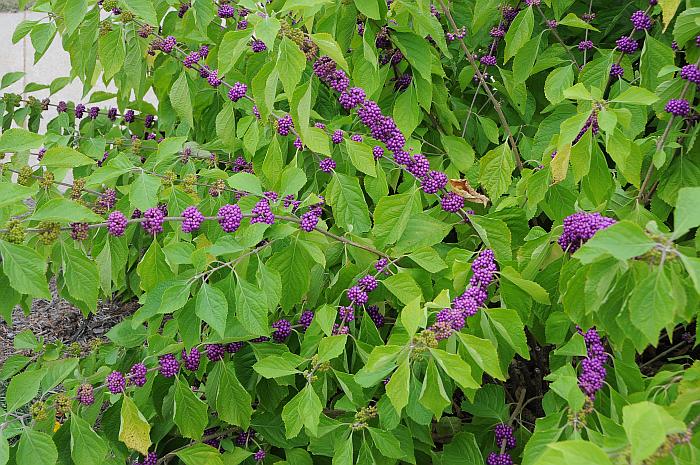Callicarpa americana L.
American Beautyberry

Native
CC = 10
CW = 3
MOC = 3
SRank = S1
© SRTurner
Callicarpa americana L.American Beautyberry | |
 |
Native CC = 10 CW = 3 MOC = 3 SRank = S1 |
© SRTurner |
|
Family - Lamiaceae Habit - Shrub, incompletely monoecious. Stems - Ascending or arching, to 1.5 m, stout, scurfy and densely hairy with short-stalked stellate or dendritic hairs, these sometimes wearing off with age.
Leaves - Opposite, petiolate, simple. Petioles 5-35 mm, longer than inflorescence stalks, usually densely stellate-hairy. Blades 5-23 cm, broadly ovate or elliptic, tapered at base, sharply pointed, coarsely and usually bluntly toothed, the surfaces stellate-pubescent, the undersurface inconspicuously glandular, the upper surface becoming glabrous with age.
Inflorescences - Small, dense, axillary, paniculate clusters of numerous flowers, the stalk 1-5 mm long.
Flowers - Calyces actinomorphic, cup-shaped, 1.5-1.8 mm long, very shallowly 4-lobed, the lobes broadly triangular. Corollas actinomorphic, 4.0-4.5 mm long, light pink to pale purple or blue, the 4 lobes shorter than the tube. Stamens 4, present (but not necessarily functional) in all flowers, exserted, all similar in size, the filaments attached at the base of the corolla tube, the anthers small, the connective very short, the pollen sacs 2, parallel, yellow. Ovary present only in functionally pistillate flowers, unlobed, the style appearing terminal. Style exserted, unbranched at the tip, the stigma more or less capitate to peltate-flattened.
Fruits - Fleshy, globose drupes 3-6 mm in diameter, the outer surface purplish red to pinkish purple, sometimes bluish-tinged, shiny, the stone eventually separating into usually 4 nutlets
Flowering - June - August. Habitat - Ledges, bluff tops, forest openings. Occasionally cultivated. Origin - Native to the U.S. Lookalikes - Distantly, Symphoricarpos orbiculatus. Other info. - Except in cultivation, this species is rare in Missouri. It is a species primarily of the southeastern U.S., and the far south of Missouri is on the very edge of its range. It is an example of a plant which is showier in fruit than in flower, and is cultivated for the attractive clusters of purple fruits. When in fruit it is impossible to mistake for anything else. It is also fairly distinctive in flower, with the dense dendritic hairs on young twigs also a characteristic feature. Photographs taken in Winter Haven, Fl., 6-18-02; also at the Runge Nature Center near Jefferson City, Cole County, MO, 9-18-2015, LaBarque Creek Conservation Area, Jefferson County, MO, 7-18-2016, and Shaw Nature Reserve, Franklin County, MO, 10-11-2016 (SRTurner). |